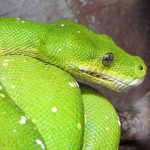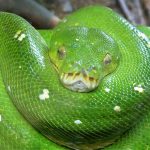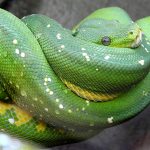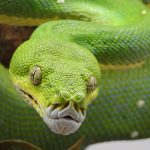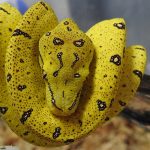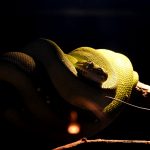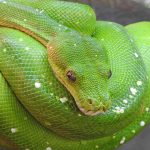GREEN TREE PYTHON
Green Tree Python
The Green tree python is a truly remarkable snake species, instantly recognisable by its brilliant emerald-green colour and graceful form. Found in the rainforests of northern Australia, as well as parts of New Guinea and eastern Indonesia, this snake is a master of blending into its leafy environment.
Physical Description
Imagine a slender, muscular snake, its scales radiant green and often speckled with small yellow or blue markings. As juveniles, Green tree pythons can be yellow, red, or even orange, gradually transforming to their signature green as they mature. Adults typically grow up to 2 metres in length, with a long, prehensile tail that helps them to navigate through the dense branches of rainforest trees.
- Size: Up to 2 metres in length
- Colour: Vivid green (adults), yellow/red/orange (juveniles)
- Notable Feature: Prehensile tail for climbing
Habitat and Behaviour
The Green tree python spends most of its life high above the ground, wrapped elegantly around branches, waiting patiently for prey. Its home is within the humid, lush rainforests where light filters through a thick canopy, casting dappled patterns over the forest floor. After dark, the python becomes more active, using its exceptional sense of smell and heat-sensitive pits to locate small mammals, birds, and sometimes reptiles.
- Habitat: Tropical rainforests, lowland and montane forests
- Behaviour: Nocturnal, arboreal (tree-dwelling)
- Diet: Small mammals, birds, reptiles
Sensory Experiences
Imagine moving gently through a rainforest at dusk. The air is warm and thick with moisture, carrying the faint scent of earth and leaves. Overhead, a Green tree python rests motionless, its cool scales luminous against the vibrant greens of the foliage. The subtle sound of rain begins in the distance, adding rhythm to the silent watch of the python.
Reproduction and Lifecycle
During the breeding season, females lay a clutch of eggs—sometimes up to 25—and coil protectively around them, using muscular contractions to maintain a constant temperature until the young hatch. The newly emerged babies, distinctively bright in colour, seek shelter in the dense foliage, where their hues provide camouflage.
- Eggs per Clutch: Up to 25
- Parental Care: Females incubate and guard eggs
Conservation Message
Although Green tree pythons are not currently listed as endangered, they face threats from habitat loss due to logging and land clearing, as well as illegal collection for the pet trade. Protecting their rainforest habitats and promoting ethical observation and appreciation is vital to ensuring the survival of these captivating snakes in the wild.
Conclusion
The Green tree python is not only a marvel of colour and adaptation but also a symbol of the intricate balance that defines Australia’s rainforests. Its presence invites us to appreciate the delicate interactions that sustain life high in the treetops and reminds us of our responsibility to preserve these ecosystems for generations to come.

